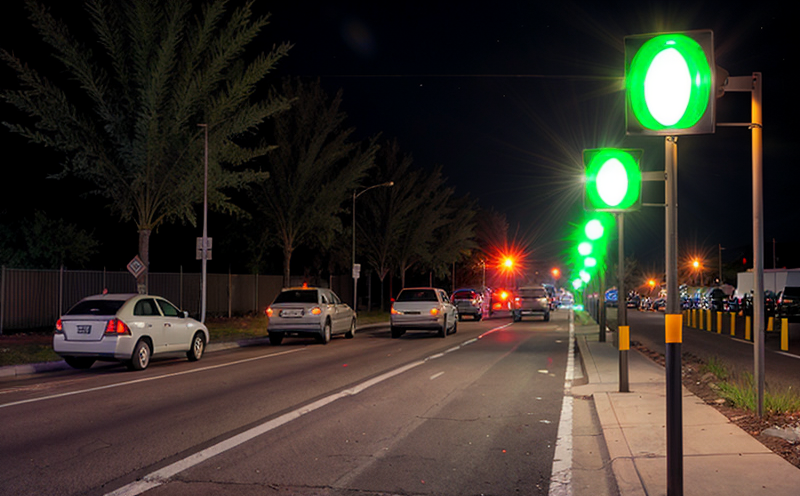IEC 62262 IK Rating Impact Testing of Traffic Signal Enclosures
The International Electrotechnical Commission (IEC) 62262 series provides a comprehensive set of standards for the impact testing and safety assessment of enclosures used in traffic signaling systems. This service focuses specifically on IEC 62262 IK Rating Impact Testing, which evaluates the durability, robustness, and integrity of traffic signal enclosures under simulated real-world conditions.
The test is critical for ensuring that traffic signal equipment can withstand potential hazards such as accidental impacts from vehicles or pedestrians. Compliance with this standard ensures that the traffic control systems are reliable and safe to operate in various environments.
Scope: The testing covers the impact resistance of enclosures against falling objects, which could include small stones, debris, or even errant pedestrians. This is particularly important for urban areas where traffic signals may be exposed to a variety of environmental stressors.
The testing protocol follows IEC 62262, which specifies the methods and criteria for assessing the impact resistance of enclosures. The test uses an impactor to simulate real-world conditions by applying force in various directions (typically vertical or horizontal) at specified impact energies.
Methodology: A detailed description follows:
- The specimen, which is typically a traffic signal enclosure, is placed on a rigid support.
- An impactor of defined mass and shape (e.g., a steel sphere) is dropped from specified heights onto the specimen.
- The test is conducted at various angles to simulate different potential impacts that might occur in real-world scenarios.
- Post-test checks are performed to evaluate any deformation, cracks, or other damage to the enclosure.
Acceptance Criteria: The specimen must withstand the impact without compromising its structural integrity. If the specimen deforms beyond a specified threshold, it fails the test.
| Impact Energy (J) | Impactor Mass (kg) | Drop Height (m) | Pass/Fail Criteria |
|---|---|---|---|
| 0.5 | 2 kg | 1 m | No visible cracks or deformations beyond specified limits. |
| 2.25 | 4 kg | 1.5 m | Same as above. |
This testing ensures that traffic signal enclosures meet the necessary safety and durability requirements, contributing to overall road safety by preventing potential malfunctions or failures due to structural damage.
Scope and Methodology
The IEC 62262 standard is designed to ensure that traffic signal enclosures are robust enough to withstand the rigors of urban environments. The testing process involves a series of impact tests conducted in accordance with specific parameters outlined in the standard.
Scope: This service encompasses the evaluation of traffic signal enclosures against various simulated impacts, focusing on their resistance to falling objects such as small stones or debris. The goal is to ensure that the enclosures can perform reliably under real-world conditions without compromising safety.
The methodology involves placing the specimen (traffic signal enclosure) in a controlled environment and subjecting it to an impact from a specified mass using a defined drop height. The test measures the resilience of the enclosure against impacts at different energies, typically ranging from 0.5 joules up to higher levels depending on the specific requirements.
The process is designed to simulate real-world conditions as closely as possible, ensuring that the enclosures are durable and reliable in operation. Compliance with IEC 62262 not only ensures safety but also enhances public trust by demonstrating adherence to international standards.
Industry Applications
Traffic signal enclosures are crucial components of urban infrastructure, providing essential information to drivers and pedestrians. Ensuring their robustness is vital for maintaining traffic flow and enhancing road safety. Here are some key applications:
| Application | Description |
|---|---|
| City Traffic Signal Systems | Enclosures protect traffic signals in urban areas, where they are exposed to a variety of environmental elements. |
| Roadway Infrastructure | Safeguards against accidental impacts from vehicles and pedestrians along highways. |
| Public Transportation | Ensures the reliability of signals at bus stops and transit intersections. |
The robustness tested through IEC 62262 ensures that these critical components continue to function effectively, even in harsh environments. This is particularly important for maintaining traffic flow and enhancing safety.
Why Choose This Test
- Enhanced Safety: Ensures compliance with international standards, reducing the risk of accidents due to equipment failure.
- Durability: Proves that enclosures can withstand real-world impacts without compromising performance or safety.
- Compliance Assurance: Validates adherence to IEC and other relevant standards, ensuring regulatory compliance.
- Potential Savings: By identifying potential issues early in the design process, this test can save on costly redesigns later.
- Improved Reputation: Demonstrates a commitment to quality and safety, enhancing brand reputation with stakeholders.
- Long-Term Reliability: Ensures that traffic signals remain operational for extended periods, reducing maintenance costs.
The IEC 62262 IK Rating Impact Testing is essential for any organization involved in the design and production of traffic signal enclosures. It provides a rigorous assessment of durability and safety, ensuring that these critical components can withstand real-world conditions.





